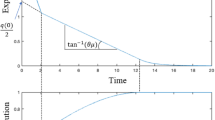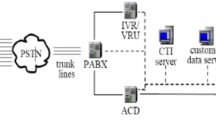Abstract
We consider queueing networks for which the performance measureJ ( θ ) depends on a parameter θ, which can be a service time parameter or a buffer size, and we are interested in sensitivity analysis of J ( θ ) with respect to θ. We introduce a new method, called customer-oriented finite perturbation analysis (CFPA), which predicts J ( θ + Δ ) for an arbitrary, finite perturbation Δ from a simulation experiment at θ. CFPA can estimate the entire performance function (by using a finite number of chosen points and fitting a least-squares approximating polynomial to the observation) within one simulation experiment. We obtain CFPA by reformulating finite perturbation analysis (FPA) for customers. The main difference between FPA and CFPA is that the former calculates the sensitivities of timing epochs of events, such as external arrivals or service time completions, while the latter yields sensitivities of departure epochs of customers. We give sufficient conditions for unbiasedness of CFPA. Numerical examples show the efficiency of the method. In particular, we address sensitivity analysis with respect to buffer sizes and thereby give a solution to the problem for which perturbation analysis was originally built.
Similar content being viewed by others
References
Baccelli, F., and Brémaud, P. 1993. Virtual customers in sensitivity and light traffic analysis via Campbell's formula for point processes. Adv. Appl. Prob. 25: 221–234.
Bao, G., Cassandras, C., and Zazanis, M. 1997. First and second derivative estimators for closed Jackson-like queueing networks using perturbation analysis techniques. J. of Discrete Event Dynamic Systems 7: 29–68.
Box, G., and Drapper, N. 1987. Empirical Model-Building and Response Surfaces. New-York: Wiley.
Bratley, P., Fox, B., and Schrage, L. 1987. A Guide to Simulation (Second Edition). New-York: Springer.
Brémaud, P., and Massoulie, L. 1995. Maximal coupling rare perturbation analysis with a random horizon. J. of Discrete Event Dynamic Systems 5: 319–342.
Brémaud, P., and Vázquez-Abad, F. 1992. On the pathwise computation of derivatives with respect to the rate of a point process: The phantom RPA method. QUESTA 10: 249–270.
Brémaud, P., and Lasgouttes, J.-M. 1993. Stationary IPA estimates for non smooth G/G/1/∞functionals via Palm inversion and level-crossing analysis. J. of Discrete Event Dynamic Systems 3: 347–374.
Cao, X.-R. 1994. Realization Probabilities: The Dynamics of Queueing Networks. New-York: Springer.
Cao, X.-R. 1987. First-order perturbation analysis of a simple multi-class finite source queue. Performance Evaluation 7: 31–41.
Cassandras, C., and Strickland, S. 1983. Perturbation analytic methodologies for design and optimization of communication networks. IEEE Trans. on Selected Areas in Communications 6: 158–171.
Cheng, D. 1993. Tandem queues with general blocking: a unified model and comparison results. J. of Discrete Event Dynamic Systems 2: 207–234.
Daduna, H., and Schaβberger, R. 1993. Delay time distributions and adjusted transfer rates for Jackson networks. AFÑ 47: 342–346.
Dai, L., and Ho, Y.-C. 1995a. On derivative estimation of single-server queues via structural infinitesimal perturbation analysis. J. of Discrete Event Dynamic Systems 5: 5–32.
Dai, L., and Ho, Y.-C. 1995b. Structural infinitesimal perturbation analysis (SIPA) for discrete-event dynamic systems. IEEE Trans. on Aut. Cont. 40: 1154–1166.
Dellacherie, C., and Meyer, P. 1978. Probabilities and Potential. Paris: Hermann.
Ermakov, S., and Krivulin, N. 1994. Efficient algorithms for tandem queueing system simulation. Appl. Math. Lett. 7: 45–49.
Fu, M. 1994. Optimization via simulation: A review. Annals of OR 53: 199–247.
Geiselhart, W. 1993. Effizientes Simulieren in stochastischen Systemen (in German). Rosch-Buch, Hallstadt. Ph.D. thesis, University St. Gallen.
Glasserman, P. 1991. Gradient Estimation via Perturbation Analysis. Boston: Kluwer Academic.
Glynn, P. 1989. A GSMP formalism for discrete event systems. Proceedings of the IEEE, vol. 77, pp. 14–23.
Gong, W.-B., and Ho, Y.-C. 1990. Smoothed (conditional) perturbation analysis of discrete-event dynamical systems. IEEE Trans. on Automatic Control 39(11): 1218–1230.
Heidergott, B. 1995. Sensitivity analysis of a manufacturing workstation using perturbation analysis techniques. Int. Journal of Prod. Research 33: 611–622.
Heidergott, B. 1999. Infinitesimal perturbation analysis for queueing networks with general service time distributions. QUESTA 31: 43–58.
Ho, Y.-C., and Cao, X.-R. 1991. Perturbation Analysis of Discrete Event Systems. Boston: Kluwer Academic.
Ho, Y.-C., and Cassandras, C. 1983a. Infinitesimal and finite perturbation analysis of queueing networks. Automatica 19: 439–445.
Ho, Y.-C., and Cassandras, C. 1983b. A new approach to determine parameter sensitivities of transfer lines. Management Science 29: 700–714.
Ho, Y.-C., and Cassandras, C. 1983c. A new approach to the analysis of discrete event dynamic systems. Automatica 19: 149–167.
Ho, Y.-C., Euler, M., and Chien, T. 1979. A gradient technique for general buffer storage design in a serial production line. Int. Journal of Prod. Research 17: 557–580.
Ho, Y.-C., and Li, S. 1988. Extensions of infinitesimal perturbation analysis. IEEE Trans. on Automatic Control 33: 427–438.
Ho, Y.-C., Shi, L., Dai, L, and Gong, W.-B. 1992. Optimizing discrete event dynamic systems via the gradient surface method. J. of Discrete Event Dynamic Systems 2: 99–120.
Hu, J.-Q. 1992. Convexity of sample path performance and strong consistency of infinitesimal perturbation analysis. IEEE Trans. Aut. Cont. 37(2).
Jackman, J., and Johnson, M. 1989. Sensitivity analysis of serial transfer lines using finite perturbation analysis. Int. Jour. of Systems Science 20: 129–137.
Krivulin, N. 1993. Unbiased estimates for gradients of stochastic network performance measures. Acta Applicandae Mathematicae 33: 21–43.
Krivulin, N. 1995. A max-algebra approach to modeling and simulation of tandem queueing systems. Mathl. Comput. Modelling 22: 25–37.
Kushner, H., and Clark, D. 1978. Stochastic Approximation Methods for Constrained and Unconstrained Systems. New-York: Springer-Verlag.
L'Ecuyer, P., and Vázquez-Abad, F. 1997. Functional estimation with respect to a threshold parameter via dynamic split and merge. J. of Discrete Event Dynamic Systems 7: 69–92.
Lucca, H. 1992. A new approach to compute performance sensitivities of stochastic discrete event dynamic systems. Operations Research 92, pp. 78–81. Heidelberg: DGOR, Physica-Verlag.
Myers, R. 1977. Response Surface Methodology. Boston, MA: Allyn and Bacon.
Pflug, G. 1996. Optimization of Stochastic Models. Boston: Kluwer Academic.
Reiman, M. 1987. Simterpolations: estimating an entire queueing function from a single sample path. Proceedings of the 1987 Winter Simulation Conference. A. Thesen, H. Grant, W. D. Kelton, ed., pp. 358–363.
Rubinstein, R., and Shapiro, A. 1993. Discrete Event Systems: Sensitivity Analysis and Optimization by the Score Function Method. Wiley.
Schaβberger, R., and Daduna, H. 1987. Sojourn times in queueing networks with multi-server nodes. J. App. Prob. 24: 511–521.
Shi, L. 1996a. Discontinuous perturbation analysis of discrete event dynamic systems. IEEE Trans. on Automatic Control 41: 1676–1681.
Shi, L. 1996b. Variance properties of discontinuous perturbation analysis. Proceedings of the 1996 Winter Simulation Conference. J. Charnes, D. Morrice, D. Brunner and J. Swain, eds., pp. 412–417.
Suri, R. 1989. Perturbation analysis: The state of the art and research issues explained via the G/G/1 queue. Proceedings of the IEEE, vol. 77, pp. 114–137.
Suri, R., and Cao, X.-R. 1983. The phantom customer and marked customer methods for optimization of closed queueing networks with blocking and general service times. Perform. Eval. Reviews (Special Issue): 243–256.
Vakili, P., and Yu, G.-X. 1994. Uniformization based sensitivity estimator for sensitivity estimation for a class of discrete event systems. J. of Discrete Event Dynamic Systems 4: 171–195.
Vázquez-Abad, F. 1989. Stochastic recursive algorithms for optimal routing in queueing networks. Ph.D. thesis, Division of Applied Mathematics, Brown University, USA.
Vázquez-Abad, F., L'Ecuyer, P., and Martin, B. 1996. On the linear growth of the split-and-merge simulation tree for a multicomponent age replacement model. Proceeding of the WODES 96, Edinburgh, UK, pp. 449–455.
Author information
Authors and Affiliations
Rights and permissions
About this article
Cite this article
Heidergott, B. Customer-Oriented Finite Perturbation Analysis for Queueing Networks. Discrete Event Dynamic Systems 10, 201–232 (2000). https://doi.org/10.1023/A:1008345726373
Issue Date:
DOI: https://doi.org/10.1023/A:1008345726373




